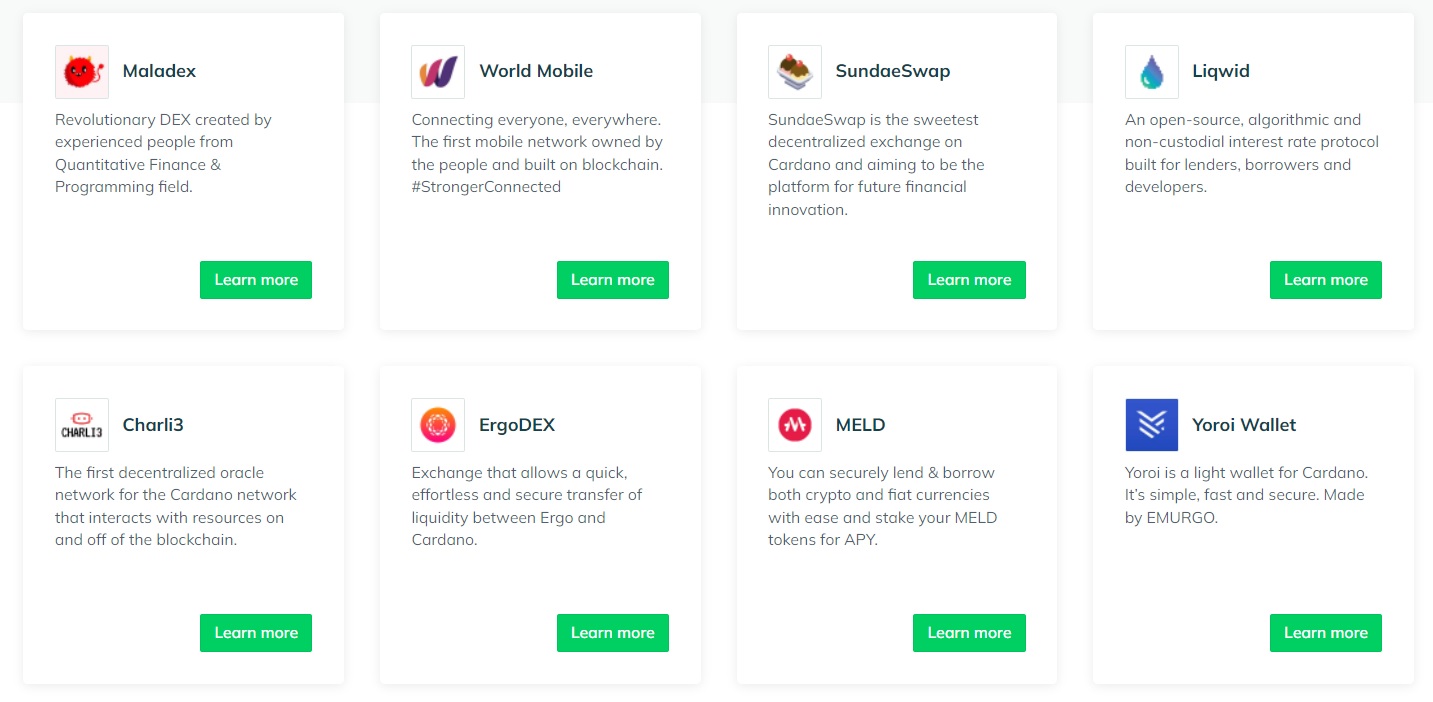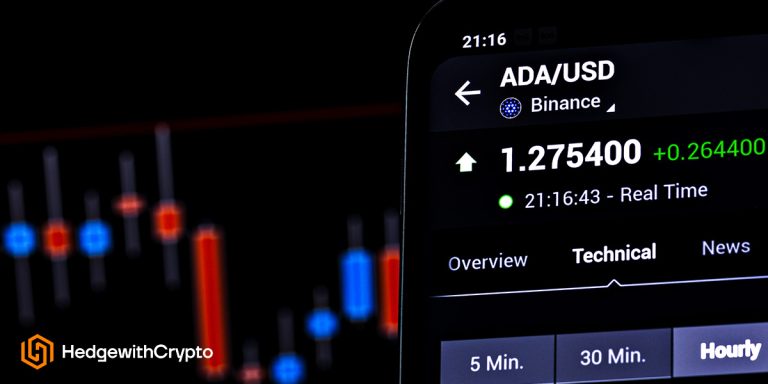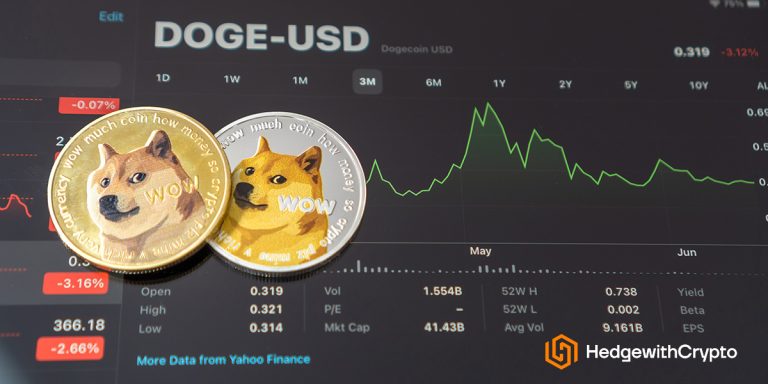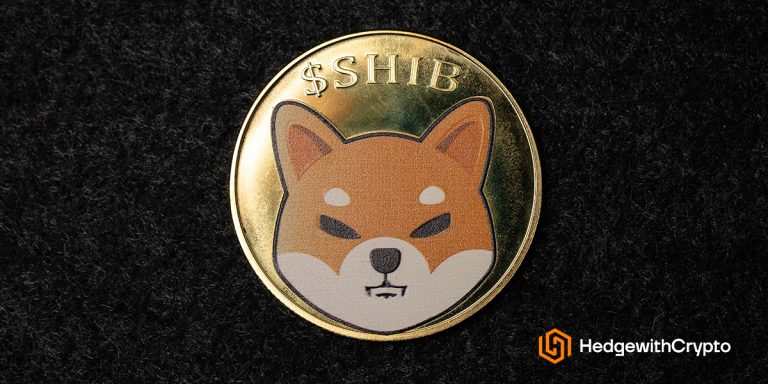Basics of Cardano & What ADA Tokens Are Used For
Key takeaways:
- Cardano is an open-source, layer-1 blockchain launched by Ethereum co-founder Charles Hoskinson.
- Developed for the implementation of smart contracts, Cardano aims to enhance interoperability, scalability, and operational sustainability.
- The highly liquid crypto asset is deflationary and has a maximum supply of 45 million.
- ADA is the native token for the blockchain and plays an essential role in the network's governance, where it can be staked to support validation.
TABLE OF CONTENTS
Cardano has become one of the largest protocols within the cryptocurrency industry. Launched in 2017, the blockchain was designed to improve upon Ethereum's failings—particularly scalability, interoperability, and sustainability. Cardano was developed using a scientific philosophy and peer-reviewed academic approach to overcome these issues.
Often referred to as a third-generation blockchain, Cardano was developed to offer solutions to businesses, governments, and enterprises globally. As such, the network can host decentralized finance (DeFi), non-fungible tokens (NFT), and Web3 applications. With the long-awaited Alonzo upgrade bringing smart contract functionality, many investors wonder if the native cryptocurrency, ADA, is a good investment for the future. This guide will explain exactly what Cardano is and how it works, evaluate the protocol’s pros and cons, and offer advice on the project’s future potential.
Cardano Explained For Beginners
Cardano is an open-source layer-1 blockchain that was developed for the deployment of smart contracts. Founded in 2015 by the co-founder of Ethereum, Charles Hoskinson, the blockchain is unique thanks to an academic peer-review approach. The protocol is supported by the Cardano Foundation, a Swiss-based non-profit, Input-Output Hong Kong (IOHK), a for-profit research and development company co-created by Hoskinson, and EMURGO, a commercially focused blockchain solutions developer.
The ambition of Cardano developers was to design a blockchain that could solve issues faced by first and second-generation blockchains, such as Bitcoin and Ethereum. Specifically, the blockchain seeks to improve scalability and interoperability and ensure the sustainability of operations. With these ambitions in mind, Cardano developers created several proprietary technologies that allow the blockchain to do just that.

The Use-Cases of Cardano
The Cardano blockchain can host a range of decentralized applications (dApps). With the network’s quick transaction speeds and ability to scale, these dApps can facilitate a wide variety of use cases. Although DeFi, NFTs, and metaverse are the key focus of dApp developers, the blockchain is capable of expanding beyond that as new sectors of the cryptocurrency industry evolve. At the time of writing, there are over 750 dApps on the Cardano ecosystem.

Pros & Cons of Cardano
The excitement surrounding Cardano’s potential is clear. However, the blockchain has also come under heavy criticism by experts within the cryptocurrency community due to its lofty ambitions and slow development of smart contracts. Before investing in Cardano, it is sensible to evaluate its pros and cons.
Cardano Pros:
- Future proof. Cardano’s developers have focused heavily on future-proofing the blockchain. Cardano’s innovative scalability and interoperability solutions should help the blockchain grow as network usage increases.
- Low fees. Thanks to the blockchain's high throughput, the transaction fees required to complete transactions on Cardano are much lower than competitors'. In 2022, gas fees averaged 0.2 ADA, which in April 2022 is approximately $0.16.
- Open-source. The blockchain’s underlying code is open-source and can, therefore, be verified. All transactions can also be viewed and are immutable.
- Deflationary token. The native coin, ADA, has a fixed maximum supply of 45 million coins. Unlike other blockchains that continually introduce new tokens, the total number of ADA coins will never increase.
- Liquidity. Due to Cardano’s popularity, the market for ADA is highly liquid. The coin can be exchanged and traded efficiently with little slippage.
Cardano Cons:
- Smart contract deployment. Although the blockchain launched in 2017, smart contract functionality was not introduced until 2021. While Cardano developers argue that this was to ensure the blockchain was both decentralized and scalable, the blockchain is now behind competitors such as Solana and Avalanche.
- There is a low number of dApps. Compared to other layer-1 blockchains, Cardano does not yet boast a vast dApp ecosystem.
- Competitors. The issues of scalability, interoperability, and sustainability were novel in 2017. However, several other blockchains have solved these issues. As other blockchains catch up, Cardano’s unique selling points have become less unique.
- Technology is still unproven. Due to Cardano’s smart contract infancy, the blockchain has not yet stood the true test of time. Claiming high transactional throughput, advanced interoperability, and sustainability is different from actually implementing it.
This Is How Cardano Works
Alongside transactional data, Cardano is a blockchain capable of processing computations, which are more commonly referred to as smart contracts. Smart contracts are a programable set of instructions that allow for the development of decentralized applications, such as decentralized exchanges (DEXs), borrowing and lending protocols, and NFTs.
1. Blockchain
The Cardano blockchain is a decentralized ledger composed of two layers: (1) the Cardano Settlement Layer (CSL) and (2) the Cardano Computation Layer (CCL). While the CSL handles transactional data, the CCL handles computational data. Keeping the two layers separate allows for the blockchain to develop proactively, changing and updating where necessary.
Alongside the two foundational CSL & CCL layers, the blockchain implements various proprietary technologies to address scalability, interoperability, and sustainability.
2. Proof-of-stake
The first of these proprietary technologies is a Proof-of-Stake consensus mechanism called Ouroboros. The Ouroborous protocol allows Cardano to scale as network usage increases, which should allow the blockchain to grow unhampered as the dApp ecosystem grows. In comparison to Proof-of-Work blockchains, which slow down at times of high network usage, Cardano’s network of validators can distribute resources accordingly if the blockchain experiences high transactional volume.
3. Staking
Cardano’s Proof-of-Stake mechanism relies on a network of validators, also formally known as staking pool operators. Each validator within the network must stake (lock away) native ADA coins to operate a blockchain node. The number of ADA coins and the length of time staked determine the likelihood that a validator will be chosen to add a new block to the blockchain.
Within the native Ouroboros protocol, Cardano also offers a Delegated Proof-of-Stake (DPoS) mechanism, which allows ADA token holders to support other validators rather than become validators themselves. Delegators can earn a share of all rewards to support validators within the network. The staking reward is 4.99% for delegators or 5.27% for running a node. The generous rewards are the reason Cardano is one of the best staking coins.
The Ouroboros protocol allows for a throughput of 250 transactions per second (TPS). Although this is lower than layer-1 competitors, such as Solana and Fantom, a native layer-2 scaling solution, known as Hydra, is expected to take the blockchain to 2 million TPS in the future.
4. Sidechain
To improve interoperability, Cardano has also developed a KMZ sidechain protocol that allows users to use a blockchain bridge to convert Cardano to other blockchain ecosystems and vice versa. Unlike other blockchains, Cardano was designed with the intention that, in the future, it is not going to be the only blockchain used within the cryptocurrency ecosystem.
5. Treasury
The operation of Cardano has been ensured thanks to the native treasury. The treasury collects network fees and distributes them to those contributing to the blockchain. This includes those involved with operations, those solving network problems, and the developer community. By using the treasury, Cardano can ensure that it is a self-sustained cryptocurrency project, that is capable of evolving over time.
Explaining ADA Tokens And What They Can Be Used For
ADA is the native cryptocurrency of the blockchain and is essential to the Cardano ecosystem. When a transaction is completed, the coin must pay gas fees and can be staked to support the validator network. The coin provides governance to the protocol and can also be used as a medium of exchange thanks to its intrinsic value. ADA has a maximum capped supply of 45 billion coins.
Once purchased, ADA does not have to sit idly in a cryptocurrency wallet. With a growing ecosystem, the ADA coin can be utilized in various ways. It can be staked to earn ADA rewards, used to interact with decentralized applications, purchase goods and services, or provide liquidity within the growing DeFi ecosystem.
- Stake to earn ADA rewards. The Cardano blockchain is secured by a network of validators that stake native ADA coins. All validators earn ADA rewards released after a new set of transactions has been validated. Those delegating ADA tokens earn a proportional share of all rewards. Cardano staking can be completed manually through the native Yoroi wallet. Although ADA can be staked manually, most popular cryptocurrency exchanges also offer staking options, whereby the exchange acts as the validator node in the network. This is a much simpler option for beginners. Review our guide on the best ways to stake ADA to earn rewards.
- Medium of exchange. Although many will purchase ADA to hold for long-term capital gains, the ADA coin can also be used as a medium of exchange within some cryptocurrency platforms. The coin can also be used to top up crypto-backed debit cards, which can then be used to pay for everyday purchases.
- Interact with dApps. Although slow to start, Cardano is developing a strong ecosystem of decentralized applications. As these dApps are built on the Cardano blockchain, many offer ADA coin holders additional perks and services.
- Earn interest in a savings account. Several cryptocurrency exchanges and lending providers allow Cardano to be deposited onto their platforms. Depending on the platform, the asset owner can earn interest on Cardano between 1% and 10% APY. Essentially, the platform will act as a middle-man and loan the assets to other users. In return, the person who deposits the ADA tokens is rewarded for lending their assets.
- Earn yield from DeFi. The decentralized finance (DeFi) ecosystem is composed of dApps that offer users the ability to swap, lend, borrow, and trade without needing a centralized intermediary. Most DeFi applications rely heavily on user-supplied liquidity, providing token holders yield-earning opportunities. Opportunities include becoming a liquidity provider or yield farming. Although returns can be high, earning yield from DeFi apps is only suitable for advanced cryptocurrency users.
The Cardano Wallet
IOHK and Emurgo have released two native cryptocurrency wallets that allow users to interact with the Cardano blockchain. The wallets, Daedalus and Yoroi, were developed for slightly different end-users.
Daedalus is the protocol’s native full-node desktop wallet that allows users to establish a validator node within the network. The wallet can be synced with the Cardano blockchain to facilitate validation and security procedures. In comparison, Yoroi is referred to as a “light” mobile and web-based wallet suitable for day-to-day transactions. The Yoroi wallet allows ADA token holders to delegate tokens to validators within the Cardano network.
Storing ADA Tokens
All cryptocurrencies, including ADA, must be stored within a cryptocurrency wallet. Each cryptocurrency wallet provides a public key that acts as an address for transferring digital assets and a private key that is used to sign and approve all transactions. While the public address can be shared with people, the private key must be kept extremely secure.
Cryptocurrency wallets can be grouped into two distinct categories: (1) hot wallets and (2) cold wallets.
- Hot wallets. A hot wallet is a cryptocurrency wallet that is either constantly or frequently connected to the internet. These types of wallets are typically either mobile applications, desktop applications, or web-based extensions. Hot wallets are extremely convenient for investors and can be connected to blockchains and dApps extremely quickly. However, frequent connection with the internet leaves these wallets more vulnerable to hacking attempts.
- Cold wallets. In comparison, cold wallets are wallets that are only connected to the internet when in use. These wallets are usually a physical device, such as a hard drive or USB stick, that can be disconnected from a computer once a transaction has been completed. Cold wallets are the most secure option for investors as the device can be disconnected and stored away from the internet. For further information, read our comparison article on the best hardware wallets.
It can be prudent to separate digital assets across hot and cold wallets. Investors should keep enough ADA within a hot wallet to perform daily transactions. All other long-term holdings should then be stored offline in a cold wallet.
Frequently Asked Questions
Is Cardano Secure?
The Cardano blockchain has been designed with security as a key priority. Thanks to the blockchain’s two-layer CSL and CCL system, Cardano developers can constantly implement upgrades to enhance security features. The blockchain also consistently incentivizes members of the community to look for flaws. All destructive behavior can be prevented as long as 51% of the staked ADA coins are not controlled by malicious users.
Has Cardano Been Hacked?
Neither Cardano nor the dApps hosted on the blockchain have ever been exploited by a hack at the time of writing.
How Long To Receive Cardano Transactions?
The Cardano blockchain offers a throughput of approximately 250 transactions per second (TPS). Although the blockchain can process 250 TPS, the finality of each transaction depends on several other factors, such as network congestion. On average, the transfer time of a Cardano transaction is between 30 seconds and 5 minutes.



